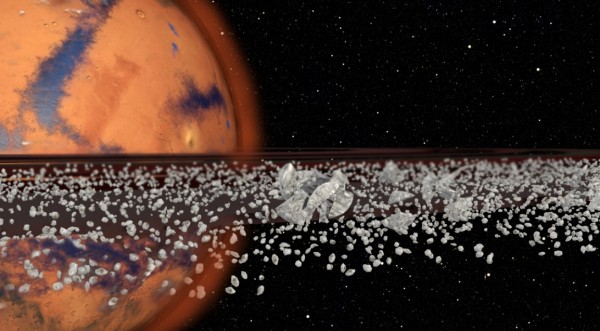By Ana Verayo, | March 22, 2017

Phobos, a Martian moon, might eventually disintegrate and form a ring around the red planet, according to a new theory by Purdue University scientists. (Purdue University Envision Center)
For a long time, astronomers have been predicting the ultimate destruction of Martian moon Phobos, where it will become a new ring around Mars. Now, a new study has revealed that this is not the first time that the moon is slowly crumbling into space rock and also, this is not the last time that Phobos is headed to its ultimate death.
Like Us on Facebook
Phobos and Deimos are considered as the tiny, odd-shaped moons of Mars. Unlike our moon, they are heavily pockmarked with impact craters and are so dark that they are considered the least reflective bodies in the solar system. Scientists consider their origins a mystery.
Scientists have also suggested that these moons are made of rubble made from carbonaceous chondrites which are also the same material found in asteroids and dwarf planets. Some have even theorized that when the massive North Polar Basin or Borealis Basin on Mars was created, this impact led to eject rocks and debris into space, which is now Phobos.
In this new study, David Minton and Andrew Hesselbrock from Purdue University suggest that this debris that formed the tiny moon Phobos apparently originated from a once existing ring around Mars. However, over time, the debris clumped together around this ancient ring and formed the moon.
Apart from this, the moons can potentially un-clump its material again. Scientists believe that this alternate Martian moon formation and ring formation processes began some 4.3 billion years ago during the formation of the North Polar Basin. The North Polar Basin also covers 40 percent of the planet.
Hesselbrock explains that this large impact would have blasted so much material from the surface of Mars that eventually formed this ring.
The team created a new Martian model and based these new findings from the rubble that form the ring and how this debris began to clump and formed Phobos. Since Phobos is closer to Mars, this process could potentially repetitive where the moon disintegrates when it approaches the planet and is torn apart by its tidal forces.
Every cycle would mean that the newly formed satellite can form five times smaller than before and the team suggests that Phobos has already gone through this process several times. Today, Phobos is on the verge of breaking apart and can become a set of rings again where debris will fall down on Mars. This cycle occurs at every 70 million years.
This new study was published in the journal, Nature Geoscience.
-
Use of Coronavirus Pandemic Drones Raises Privacy Concerns: Drones Spread Fear, Local Officials Say

-
Coronavirus Hampers The Delivery Of Lockheed Martin F-35 Stealth Fighters For 2020

-
Instagram Speeds Up Plans to Add Account Memorialization Feature Due to COVID-19 Deaths

-
NASA: Perseverance Plans to Bring 'Mars Rock' to Earth in 2031

-
600 Dead And 3,000 In The Hospital as Iranians Believed Drinking High-Concentrations of Alcohol Can Cure The Coronavirus

-
600 Dead And 3,000 In The Hospital as Iranians Believed Drinking High-Concentrations of Alcohol Can Cure The Coronavirus

-
COVID-19: Doctors, Nurses Use Virtual Reality to Learn New Skills in Treating Coronavirus Patients







